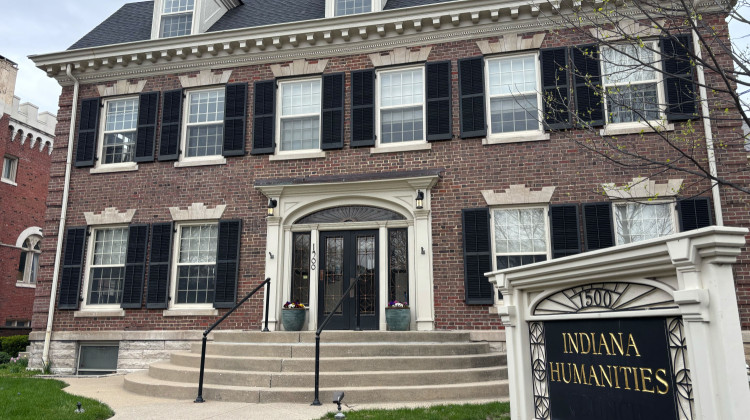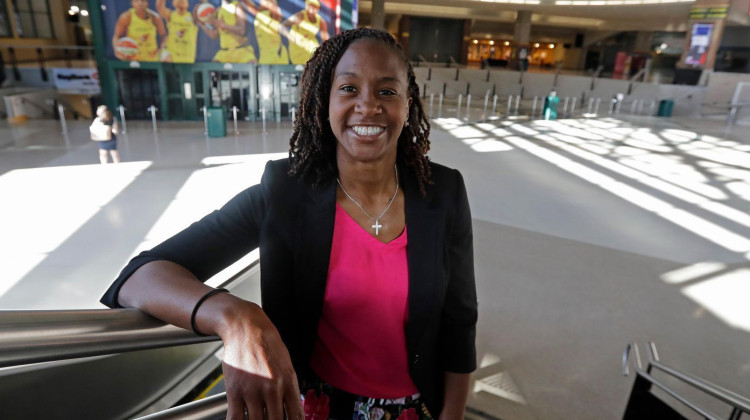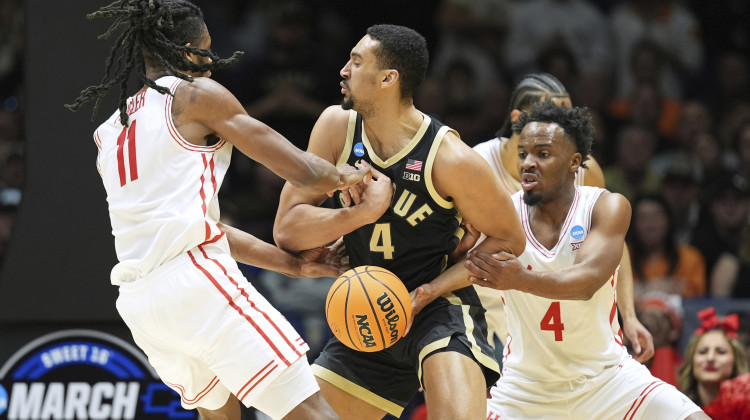
Aubrey Miles, an intern at the Benjamin Harrison Presidential Site and Jennifer Capps, VP of exhibition and curatorship, share some of the new artifacts on exhibit. (Jill Sheridan WFYI)
A new exhibit at the Benjamin Harrison Presidential Site features hundreds of letters and artifacts on view to the public for the first time. WFYI’s Jill Sheridan sat down with VP of Exhibition and Curatorship Jennifer Capps to talk about the new material and connections to the history of our 23rd President and his family.
Sheridan: Can you talk a little bit about what this new exhibit is all about?
Capps: Life in the White House is exploring Harrison's time at the White House, and more from that private family aspect of things. So, the public events, the dinners and balls and galas that are going on. But also the Harrisons have several members of their family that are living in the White House with them, including three of their very young grandchildren.
So you have those wonderful stories with the grandchildren there and different things that they're doing… that have not all been shared before, because we have some additional information that came recently to our collection.
Sheridan: Hundreds of new letters I understand as part of the exhibit, what does that tell us just about daily life in this time period, the late 1800s, and the beginnings, you know, of modern presidency?
Capps: Well, I think that it's interesting, because you see that maybe things have not changed so much. There's still those family dynamics and the things that are going on the planning, it makes them more personable, they're more relatable. And actually, the Harrisons had a little bit more of a freedom at that time than maybe the President's do today.
Caroline (Harrison) is still going out shopping, you know, without the Secret Service, but you're seeing those day to day activities. She's helping plan things she might be, you know, helping planning a menu, she's helping doing the table decorations, she had a very artistic side to her as well. So she's very involved in all of those activities at the White House.
Sheridan: Talk a little bit about these letters, they were acquired because of long relationships with descendants of the family and the importance of maintaining those relationships.
Capps: Yeah. So, you know, Benjamin Harrison had three children that lived to adulthood, and all three of those children have two children, each a boy or girl, and all of those families, we have maintained relationships with all of those branches of the family.
And this particular collection that came more recently to us in the fall of 2022, was from the McKee side of the family. So you have the daughter, Mary Harrison McKee and her children, her daughter, Mary Lodge, McKee is the the descendants are from that particular side of the family. And as families do that, you keep mementos, that particular branch of the family did still have this collection of letters, they had some artifacts as well, some of Caroline Harrison's watercolors, additional photographs also.

As they were looking through these items, centuries later, (they) decided that those should also come to our collection here at the Benjamin Harrison Presidential Site. It's wonderful to have all of these items that have been added to our collection that now we can share. They have never been seen by the public before.
Sheridan: It's obviously a very different time in history. But there are parallels, there are connections to you know, what we're experiencing now. What do you think is important about, you know, keeping these connections with past presidents?
Capps: It's interesting to see those parallels. But Harrison did a lot of things in his presidency that are rather quietly and purposely done. So you don't always remember those things. I think it's very important to look back.
The Pan American Congress started under Benjamin Harrison during his presidency, he actually set aside forest and park reserves and started all of that. Looking at all of these topics that are still important, yes, they change, but they're always different things of conservation, with, you know, tariffs and trade, that they change through the years. But there is that constant thread.
The Benjamin Harrison Presidential Site will display the new artifacts at an exhibit open through November.
Contact WFYI city government and policy reporter Jill Sheridan at jsheridan@wfyi.org.
 DONATE
DONATE






 Support WFYI. We can't do it without you.
Support WFYI. We can't do it without you.